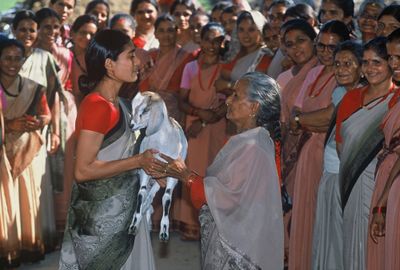Giving new meaning to green giving
Programs offer ways to help people, environment

If you’re looking for green gifts that keep on giving, you could buy a well to provide clean water for people in southeast Africa, or trees to help keep soil in place on a Tanzanian hillside.
How about a dairy goat for people in Haiti and Kenya, or an alpaca for someone in Peru or Ecuador?
An alpaca?
Yes, the alpaca ($360) is gentle on the environment, says Devin Hermanson, senior catalog director for World Vision, an international Christian relief and development organization.
When the animals graze, they gently mow the grass rather than uproot it, and their soft, padded feet are easy on pastures, he says. Their wool is valuable and can provide families a “consistent way to earn money and feed their children.”
Groups such as World Vision (worldvision.org) and Heifer International (heifer.org), have hundreds of projects designed to save and enrich lives while protecting the environment.
“All our projects are examples of agroecology or green agriculture,” says Ray White, a spokesman for Heifer International.
Among the green gift ideas: tree seedlings for $60 (a share for $10) for the environmental health of small farms, and bees ($30 for box, hive and training) that pollinate crops and produce extra income through honey.
Many communities need clean drinking water, and so wells are a green gift from the World Vision catalog. The cost of a traditional well is $5,390; a share is $75.
Goats are the most popular items purchased from both Heifer International ($120) and World Vision ($75).
How are they green?
A dairy goat can provide a family with up to several quarts of nutritious milk a day – a ton of milk a year, according to Heifer’s catalog.
“Extra milk can be sold or used to make cheese, butter or yogurt. Families learn to use goat manure to fertilize gardens,” it says.
Goats are efficient in producing milk, says Heifer’s White: “They can eat anything,” says Heifer’s White. “They don’t have to have grain. They eat kitchens scraps, elephant grass, leaves.
“In fact, you have to watch your clothes around goats. They will literally eat them, too.”
Does your money really go to buy goats, cows and trees?
“In the ideal world, if you buy a goat, a family gets a goat,” says World Vision’s Hermanson. “But as we’ve gotten bigger, it has been harder to do this with integrity.
“So now we say that most of your gift will go for a goat, but some of it might go to buy chickens or another item in the same category.”
At Heifer, donations go into a fund, White explains: “The instant you give us 120 bucks, we don’t go out and buy a sheep. The record-keeping involved in tracking all those animals would be prohibitively expensive. The money goes into a pool, and when someone in a community is ready to receive an animal, we acquire the animal and take it to a site.
”The projects sometimes include money for the materials to build sturdy shelters for the animals and seeds or seedlings. We don’t just drop off animals and leave. We spend three to five years in communities to make sure they are self-reliant.“